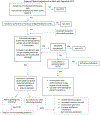Postural Orthostatic Tachycardia Syndrome (POTS): A critical assessment
- PMID: 32222376
- PMCID: PMC9012474
- DOI: 10.1016/j.pcad.2020.03.010
Postural Orthostatic Tachycardia Syndrome (POTS): A critical assessment
Abstract
Although diagnostic criteria have been developed characterizing postural orthostatic tachycardia syndrome (POTS), no single set of criteria is universally accepted. Furthermore, there are gaps in the present criteria used to identify individuals who have this condition. The reproducibility of the physiological findings, the relationship of symptoms to physiological findings, the presence of symptoms alone without any physiological findings and the response to various interventions confuse rather than clarify this condition. As many disease entities can be confused with POTS, it becomes critical to identify what this syndrome is. What appears to be POTS may be an underlying condition that requires specific therapy. POTS is not simply orthostatic intolerance and symptoms or intermittent orthostatic tachycardia but the syndrome needs to be characterized over time and with reproducibility. Here we address critical issues regarding the pathophysiology and diagnosis of POTS in an attempt to arrive at a rational approach to categorize the syndrome with the hope that it may help both better identify individuals and better understand approaches to therapy.
Keywords: Orthostatic intolerance; Postural orthostatic tachycardia; Tachycardia.
Copyright © 2020 Elsevier Inc. All rights reserved.
Figures
Comment in
-
Special Assorted Topics 2021.Prog Cardiovasc Dis. 2021 Jul-Aug;67:1. doi: 10.1016/j.pcad.2021.07.011. Prog Cardiovasc Dis. 2021. PMID: 34412824 No abstract available.
References
-
- Rosen SG, Cryer PE. Postural tachycardia syndrome. Reversal of sympathetic hyperresponsiveness and clinical improvement during sodium loading. Am J Med 1982;72:847–850. - PubMed
-
- Schondorf R, Low PA. Idiopathic postural orthostatic tachycardia syndrome: an attenuated form of acute pandysautonomia? Neurology 1993;43:132–137. - PubMed
-
- Wooley CF. Where are the diseases of yesteryear? DaCosta’s syndrome, soldiers heart, the effort syndrome, neurocirculatory asthenia–and the mitral valve prolapse syndrome. Circulation 1976;53:749–751. - PubMed
-
- Taylor AA, Davies AO, Mares A, et al. Spectrum of dysautonomia in mitral valvular prolapse. Am J Med 1989;86:267–274. - PubMed
Publication types
MeSH terms
Grants and funding
LinkOut - more resources
Full Text Sources
Medical
Research Materials


